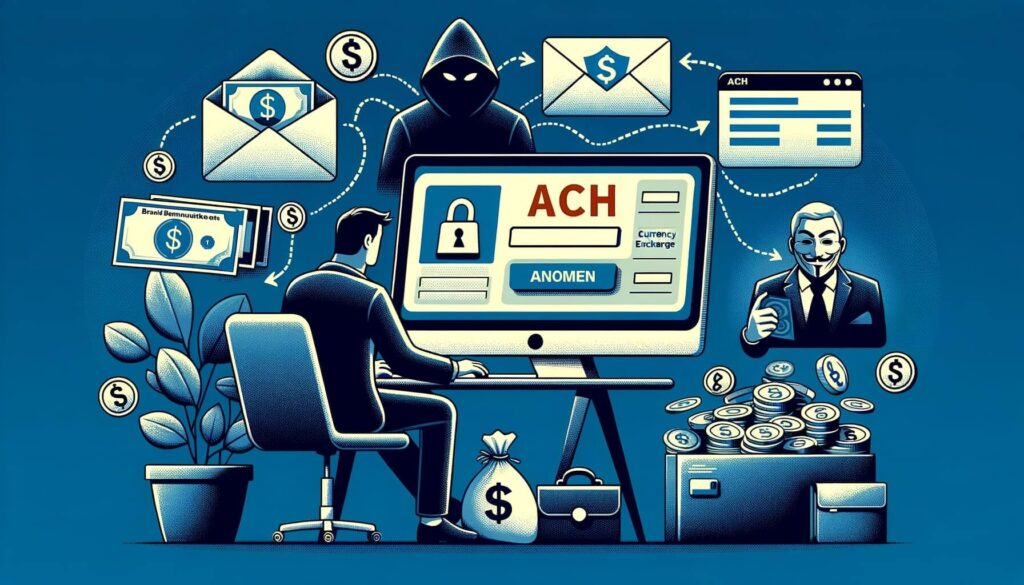
By Ava Owen April 22, 2025
In today’s digital age, financial fraud has become increasingly sophisticated, with criminals constantly finding new ways to exploit vulnerabilities in the system. One such form of fraud is ACH (Automated Clearing House) fraud, which involves unauthorized electronic transfers of funds from one bank account to another. This article aims to provide a comprehensive guide to understanding ACH fraud, how these scams work, and most importantly, how to prevent them.
ACH Fraud is a type of cybercrime that targets the Automated Clearing House network, a system used by financial institutions to process electronic transactions. This network handles a wide range of transactions, including direct deposits, bill payments, and business-to-business payments. Criminals exploit weaknesses in this system to gain unauthorized access to bank accounts and transfer funds to their own accounts.
How ACH Fraud Scams Work: A Step-by-Step Guide

To understand how ACH fraud scams work, let’s walk through a step-by-step guide of a typical scenario. It’s important to note that criminals may use various techniques and strategies, but the underlying principles remain the same.
Step 1: Gathering Information
The first step for fraudsters is to gather information about potential victims. This can be done through various means, such as phishing emails, social engineering, or data breaches. They may collect personal information, account details, and login credentials to gain access to the victim’s bank account.
Step 2: Gaining Access to the Victim’s Account
Once the fraudsters have obtained the necessary information, they use it to gain unauthorized access to the victim’s bank account. This can be done by impersonating the victim or by exploiting vulnerabilities in the bank’s security systems.
Step 3: Initiating Unauthorized ACH Transfers
With access to the victim’s account, the fraudsters initiate unauthorized ACH transfers to their own accounts or to accounts controlled by accomplices. These transfers are often disguised as legitimate transactions, making it difficult for the victim or the bank to detect the fraud.
Step 4: Laundering the Stolen Funds
To cover their tracks, the criminals often launder the stolen funds through a series of transactions, making it difficult to trace the money back to its source. They may use various techniques, such as shell companies, offshore accounts, or cryptocurrency exchanges, to obscure the origin of the funds.
Common Techniques Used in ACH Fraud Scams

ACH fraudsters employ a variety of techniques to carry out their scams. Understanding these techniques can help individuals and businesses identify potential red flags and take appropriate preventive measures. Some common techniques used in ACH fraud scams include:
1. Phishing: Fraudsters send deceptive emails or text messages that appear to be from legitimate sources, such as banks or financial institutions. These messages often contain links or attachments that, when clicked or opened, install malware on the victim’s device or direct them to fake websites where they are prompted to enter their login credentials.
2. Social Engineering: This technique involves manipulating individuals into divulging sensitive information or performing actions that benefit the fraudsters. Common social engineering tactics include impersonating bank employees, posing as trusted individuals, or creating a sense of urgency to prompt immediate action.
3. Malware: Fraudsters use malicious software, such as keyloggers or remote access trojans, to gain unauthorized access to victims’ devices. This allows them to monitor keystrokes, capture login credentials, or take control of the device remotely.
4. Account Takeover: In an account takeover, fraudsters gain unauthorized access to a victim’s bank account by using stolen login credentials or by exploiting vulnerabilities in the bank’s security systems. Once inside, they can initiate unauthorized ACH transfers or make other fraudulent transactions.
Red Flags to Watch Out for: Identifying Potential ACH Fraud

Being able to identify potential red flags is crucial in preventing ACH fraud. By recognizing suspicious activities or behaviors, individuals and businesses can take immediate action to protect themselves. Here are some red flags to watch out for:
1. Unexpected or Unusual Transactions: Keep an eye out for any unexpected or unusual transactions in your bank account. This could include unfamiliar payees, large transfers, or frequent transfers to the same recipient.
2. Changes in Account Information: If you notice any unauthorized changes to your account information, such as a new email address or phone number, it could be a sign of ACH fraud. Fraudsters often change contact details to prevent victims from receiving alerts or notifications about suspicious activities.
3. Unsolicited Requests for Personal Information: Be cautious of unsolicited requests for personal information, especially if they come from unknown sources. Legitimate financial institutions will never ask you to provide sensitive information, such as your account number or login credentials, via email or phone.
4. Poorly Written or Suspicious Emails: Pay attention to the quality of emails you receive from financial institutions. Poor grammar, spelling mistakes, or suspicious email addresses can indicate a phishing attempt.
Preventing ACH Fraud: Best Practices and Security Measures
Preventing ACH fraud requires a proactive approach and the implementation of best practices and security measures. By following these guidelines, individuals and businesses can significantly reduce the risk of falling victim to ACH fraud:
1. Strengthen Passwords and Enable Two-Factor Authentication: Use strong, unique passwords for all online accounts and enable two-factor authentication whenever possible. This adds an extra layer of security by requiring a second form of verification, such as a fingerprint or a one-time code sent to your mobile device.
2. Be Cautious of Suspicious Emails and Links: Exercise caution when opening emails or clicking on links, especially if they are from unknown sources or contain suspicious content. Avoid providing personal information or login credentials through email or on unfamiliar websites.
3. Regularly Monitor Bank Accounts: Regularly review your bank statements and transaction history to identify any unauthorized or suspicious activities. Report any discrepancies to your bank immediately.
4. Keep Software and Devices Updated: Regularly update your operating system, antivirus software, and other applications to ensure they have the latest security patches. Outdated software can be vulnerable to exploitation by fraudsters.
Strengthening Your ACH Security: Tips for Individuals and Businesses
In addition to the general best practices mentioned above, there are specific steps individuals and businesses can take to strengthen their ACH security:
For Individuals:
1. Educate Yourself: Stay informed about the latest ACH fraud techniques and scams. Knowledge is your best defense against fraudsters.
2. Use Secure Wi-Fi Networks: Avoid conducting financial transactions or accessing sensitive information on public Wi-Fi networks. Use secure, password-protected networks whenever possible.
3. Regularly Check Credit Reports: Monitor your credit reports regularly to detect any unauthorized accounts or suspicious activities. This can help you identify potential identity theft or fraud.
For Businesses:
1. Implement Strong Internal Controls: Establish robust internal controls and segregation of duties within your organization. This ensures that no single individual has complete control over financial transactions.
2. Conduct Regular Employee Training: Train your employees on ACH fraud prevention and security best practices. Make them aware of the risks and teach them how to identify and report suspicious activities.
3. Use Dual Authorization for Transactions: Require dual authorization for all ACH transactions, especially for large transfers or payments to new or unfamiliar recipients. This adds an extra layer of security by requiring approval from multiple individuals.
ACH Fraud Prevention Tools and Technologies
To further enhance ACH fraud prevention efforts, individuals and businesses can leverage various tools and technologies designed to detect and mitigate fraudulent activities. Some of these tools include:
1. Fraud Detection Software: Implement fraud detection software that uses advanced algorithms and machine learning to analyze transaction patterns and identify suspicious activities.
2. Real-Time Transaction Monitoring: Utilize real-time transaction monitoring systems that can detect and flag potentially fraudulent transactions as they occur. These systems can help prevent unauthorized transfers before they are completed.
3. Positive Pay Services: Consider using positive pay services offered by banks. This service requires businesses to submit a list of authorized payees and transaction details. The bank then verifies each transaction against the submitted list, reducing the risk of fraudulent transfers.
Reporting ACH Fraud: What to Do if You Become a Victim
Despite taking all necessary precautions, individuals and businesses can still fall victim to ACH fraud. If you suspect that you have become a victim of ACH fraud, it is crucial to take immediate action. Here are the steps you should follow:
1. Contact Your Bank: Notify your bank or financial institution as soon as possible. They will guide you through the process of securing your account, reversing unauthorized transactions, and preventing further fraudulent activities.
2. File a Police Report: Report the incident to your local law enforcement agency. Provide them with all relevant information, including any evidence or documentation you may have.
3. Report to the Appropriate Authorities: Depending on the jurisdiction and nature of the fraud, you may need to report the incident to other authorities, such as the Federal Trade Commission (FTC) or the Internet Crime Complaint Center (IC3).
4. Monitor Your Accounts: Continuously monitor your bank accounts and credit reports for any further unauthorized activities. Consider placing a fraud alert or credit freeze on your accounts to prevent further damage.
Frequently Asked Questions (FAQs) about ACH Fraud
Q1. What is ACH fraud?
Answer: ACH fraud is a type of cybercrime that involves unauthorized electronic transfers of funds from one bank account to another. Criminals exploit vulnerabilities in the Automated Clearing House network to gain access to bank accounts and transfer funds to their own accounts.
Q2. How can I protect myself from ACH fraud?
Answer: To protect yourself from ACH fraud, follow best practices such as using strong passwords, enabling two-factor authentication, being cautious of suspicious emails and links, and regularly monitoring your bank accounts for any unauthorized activities.
Q3. Can businesses be targeted by ACH fraud?
Answer: Yes, businesses are also vulnerable to ACH fraud. Implementing strong internal controls, conducting regular employee training, and using dual authorization for transactions can help businesses prevent ACH fraud.
Q4. What should I do if I suspect ACH fraud?
Answer: If you suspect ACH fraud, immediately contact your bank or financial institution, file a police report, and report the incident to the appropriate authorities. Continuously monitor your accounts for further unauthorized activities.
Conclusion
ACH fraud poses a significant threat to individuals and businesses alike. Understanding the basics of ACH fraud, how these scams work, and the preventive measures to take is crucial in staying vigilant against this type of cybercrime.
By implementing best practices, leveraging security measures and technologies, and promptly reporting any suspicious activities, individuals and businesses can significantly reduce the risk of falling victim to ACH fraud. Remember, prevention is always better than cure when it comes to financial fraud. Stay informed, stay cautious, and stay one step ahead of the fraudsters.